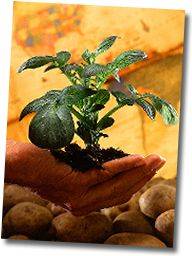Small, round spots, ranging in size from 1/16" to 1/2" in
diameter, appear on the upper sides of leaves. Leaf tissue adjacent to the spot
turns yellow. Whole leaves eventually turn yellow and fall prematurely. Black
spot can be distinguished from other leaf spot diseases of rose by the generally
fringed margins and the darker and consistently black color of the leaf spots.
Similar spots may appear on petioles and fruit. Raised, reddish-purple spots may
also appear on canes. If black spot is left uncontrolled and early defoliation
occurs, bushes are weakened and cane dieback the following spring may be severe.
Weakened plants may continue to die even after the plants leaf out.
Disease Cycle
During dormancy the fungus survives in infected canes and
fallen leaves. Spores are spread to the highly susceptible, young, unfolding
leaves in spring by splashing water. Infection takes place only when water
remains on the leaves for seven or more hours. Therefore, the disease is most
serious in regions of high rainfall and high humidity. Because the fungus
tolerates a wide range of temperatures, symptoms can continue to develop all
season long if moisture is adequate.
Control
Cultural Control
A preventative program for black spot should begin in the fall
with a thorough sanitation program. Diseased leaves on the ground should be
raked and burned or removed. All diseased canes should be pruned back to healthy
wood. These practices will reduce the amount of overwintering fungus. During the
growing season, overhead irrigation, which prolongs leaf wetness, should be
avoided. If plants are overhead irrigated, watering should be done in the
morning rather than the afternoon so that leaves dry quickly.
Chemical Control
Fungicides registered for black spot control should be applied
preventatively to susceptible roses starting in spring before the new leaves
become spotted. From this time through frost, the plants should never pass
through a rainy period without a protective coating of fungicide on the leaves.
Fungicides registered for black spot control include propiconazole (e.g.
Banner), thiophanane methyl (e.g. Cleary 3336), chlorothalonil (e.g. Daconil
2787), mancozeb (e.g. Fore, Dithane, or Maneb), thiophanate methyl + mancozeb
(e.g. Zyban), trifloxystrobin (e.g. Compass) and myclobutanil (e.g. Systhane).
Most of these fungicides can be sprayed at 7-10 day intervals when rains are
infrequent. During rainy weather, it may be necessary to spray the plants more
frequently. Details on rates and timing of application can be found the current
Virginia Pest Management Guide for Home Grounds and Animals (VCE Publication
456-018) or the Virginia Pest Management Guide for Horticultural and Forest
Crops (VCE Publication 456-017),
http://www.ext.vt.edu/pubs/pmg/. For information on the proper use of
pesticides and fungicides, refer to any current VCE pest management guide.
Resistance
The most effective way to prevent black spot is to plant roses
that have resistance to the disease. Most roses get black spot to some degree,
but roses that have been bred for resistance to this and another common disease
of roses, powdery mildew, will require less maintenance than those that are
known to be susceptible to these diseases. Some hybrids and cultivars that
showed good to excellent resistance to both black spot and powdery mildew in a
1990 survey in Maryland are listed below (Table 1). Note that the degree of
resistance exhibited by these roses in a given landscape may vary somewhat
depending on local environmental conditions.
![]() Gardeners' Corner
Kids'
Garden
Sustainable Garden
Contact Us
Gardeners' Corner
Kids'
Garden
Sustainable Garden
Contact Us![]()


